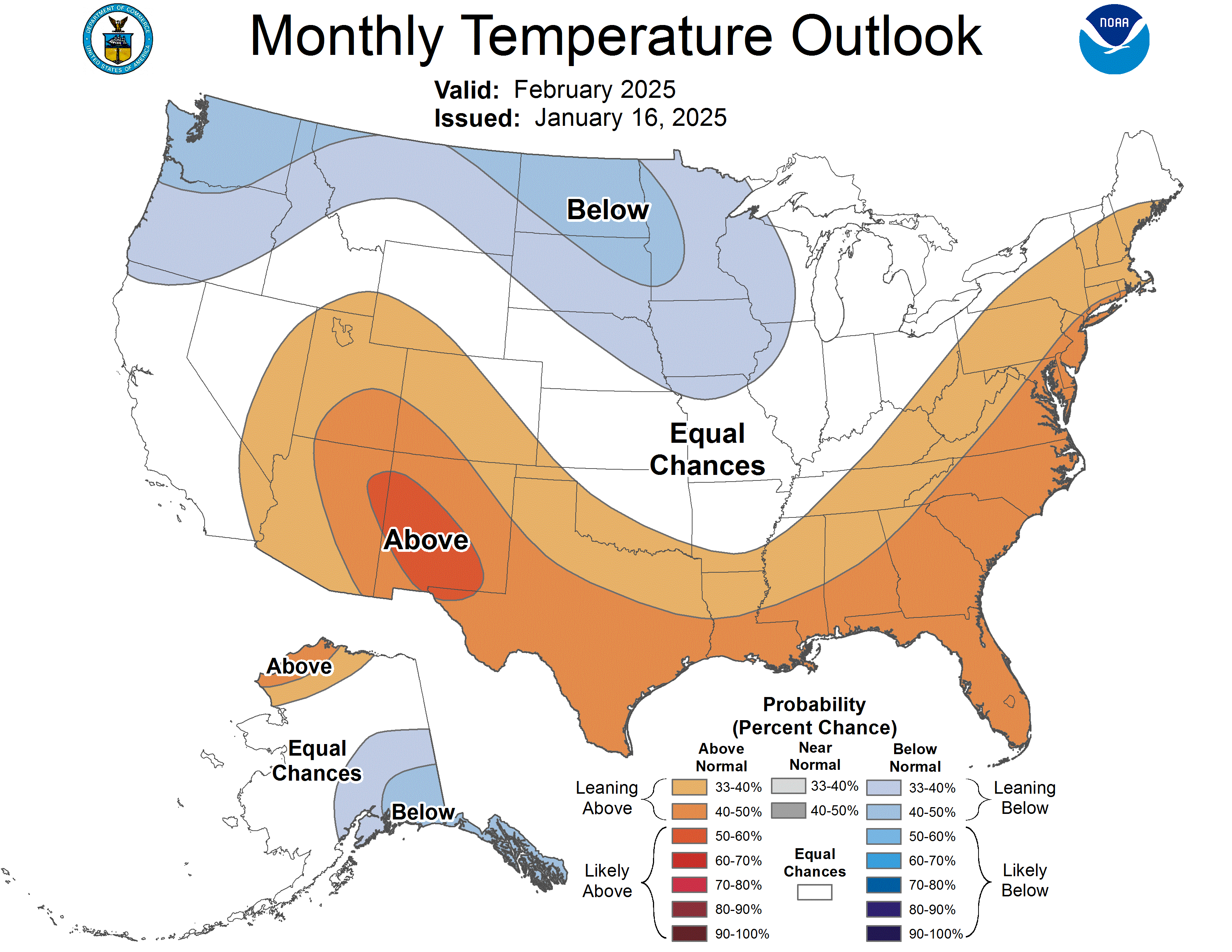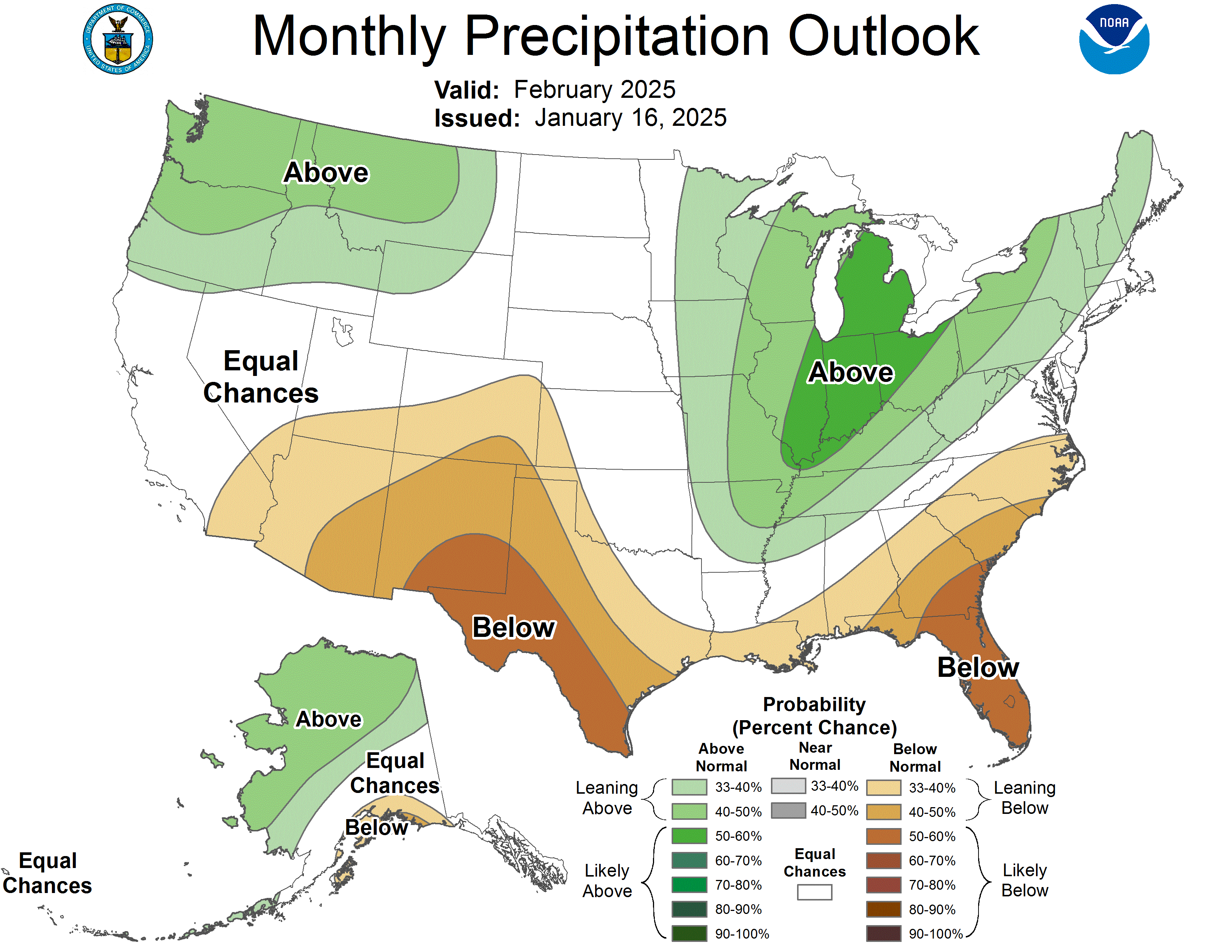
The NOAA just released its outlook for February 2025. It’s looking good for northern regions, and also the northeast.
tl;dr: La Niña conditions are expected to influence February 2025 weather patterns across the United States. The forecast predicts above-normal temperatures for much of the southern and eastern U.S., while the northern regions may experience below-normal temperatures. Precipitation is likely to be above-normal in the Pacific Northwest, Northern Rockies, and much of the northern and central U.S., with below-normal precipitation expected in the Southwest, southern Plains, and Southeast.
- Related: [UPDATED: December 20] NOAA Winter 2024-25 Forecast: La Niña and the Rest of the Ski Season
A summary is below, and the full discussion at the bottom.
La Niña’s Influence on February 2025 Weather
A weak La Niña has finally emerged, shaping the weather patterns for February 2025. This climate phenomenon, characterized by cooler-than-average sea surface temperatures in the central and eastern Pacific, is expected to persist through the Feb-Mar-Apr season with a 59% probability.
Temperature Outlook
Skiers and snowboarders should take note of the temperature predictions for February 2025. The forecast suggests above-normal temperatures for the Southwest, southern Plains, and much of the eastern United States. However, snow enthusiasts might find better conditions in the Pacific Northwest, Montana, Northern and Central Plains, and the Upper Mississippi Valley, where below-normal temperatures are more likely.
Precipitation Forecast
The precipitation outlook brings good news for many ski resorts in the northern regions. Above-normal precipitation is expected from the Pacific Northwest across the Northern Rockies to the northern High Plains. This could translate to significant snowfall for mountain resorts in these areas. The Mississippi Valley, Great Lakes region, and parts of the Northeast are also likely to see above-normal precipitation.
Dry Conditions in the South
Southern ski destinations may face challenges this February. Below-normal precipitation is predicted for much of the southern United States, including southern California, the Four Corners region, Texas, and parts of the Southeast. This could mean less-than-ideal snow conditions for resorts in these areas.
Implications for Skiers and Snowboarders
Based on this forecast, the northern ski resorts are likely to offer the best conditions in February 2025. Areas like the Pacific Northwest, Northern Rockies, and northern New England could see ample snowfall. However, southern resorts may struggle with warmer temperatures and less precipitation, potentially leading to less favorable skiing and snowboarding conditions.

30-DAY OUTLOOK DISCUSSION FOR FEBRUARY 2025 The long-awaited transition from a neutral El Niño Southern Oscillation (ENSO) to a weak La Niña finally occurred during December 2024, with the latest weekly value of the Oceanic Niño Index (ONI) of -0.7C for the Niño 3.4 region. Below-average sea-surface temperatures (SSTs) now dominate the central and east-central Pacific with significant subsurface cooling to a depth of 100-200 meters. Broad expanses of enhanced (suppressed) tropical convection are noted over the vicinity of Indonesia (Date Line), with persistently enhanced low-level trade winds over the western and central near-equatorial Pacific. La Niña conditions are expected to persist through the Feb-Mar-Apr (FMA) 2025 season with odds of 59 percent, followed by a nearly equally likely transition to ENSO-neutral starting in Mar-Apr-May (MAM) 2025. In addition to La Niña being the expected primary driver of the atmospheric circulation pattern in February, there is significant forcing associated with the Arctic Oscillation (AO) and the Madden-Julian Oscillation (MJO). The AO index has been negative during the past two weeks, which has likely contributed to the current cold snap across the central and eastern contiguous U.S. (CONUS). The AO index is forecast to transition toward its positive phase in the next 2 weeks, which may signify at least a brief reprieve from the persistent influence of Arctic air masses over this portion of the country. In the tropics, the convectively enhanced phase of the MJO is currently in the Western Hemisphere, near the interface of Realtime Multivariate MJO (RMM) Phases 8 and 1. During the past 10-14 days, there has been a very significant increase in amplitude of the MJO signal, though there has been little eastward propagation. Most RMM-based MJO Index forecasts predict a high-amplitude MJO accelerating to phase speeds more consistent of a convectively-coupled Kelvin Wave, as the signal traverses the remainder of the Western Hemisphere, Africa, the Indian Ocean, and reaches the Maritime Continent during the next two-week period. Historically, an MJO signal propagating eastward across the Indian Ocean and Maritime Continent favors a warm response downstream over the central and eastern CONUS towards the end of January, but this is contradicted by most dynamical model guidance which favors the continuation of below normal temperatures across this region. Other considerations for the February outlooks include coastal SSTs, sea and lake ice, and snow cover. At the present time, near to primarily above normal SSTs prevail near the West Coast of the CONUS, the western and central Gulf Coast, and near the southwest coast of Alaska. Below normal SSTs are observed near the coast of the Northeast CONUS. Most of the Alaska coast as far south as Kuskokwim Bay (Southwest Alaska) is dominated by sea ice. Over the Lower 48 states, the Great Lakes remain mostly ice-free as of mid-January, with relatively shallow Lake Erie being the most likely to freeze over during the next few weeks. Current snow cover is widespread across the northern and central CONUS, with associated radiational cooling helping to keep surface temperatures lower over this area. The monthly Temperature and Precipitation Outlooks for February are based on historical La Niña composites and regressions and the secondary forcings described above, as well as on dynamical and statistical model support. Dynamical support is derived from dynamical model suites including the North American Multi-Model Ensemble (NMME), Copernicus Climate Suite (C3S), and from the Climate Forecast System version 2 (CFSv2) dynamical model. Statistical support comes largely from a combined ENSO-OCN tool, and to a lesser degree the Canonical Correlation Analysis (CCA). CPC’s official outlooks for Weeks 3-4, and monthly and submonthly temperature and precipitation guidance from the Global Ensemble Forecast System (GEFS), CFSv2, and European Centre for Medium-Range Weather Forecasts (ECMWF) models are also used in the preparation of the February Outlooks, though it is important to note that these forecasts only cover the first half of February. The February 2025 Temperature Outlook features elevated odds of above normal temperatures over the vicinity of the Four Corners states/Southwest, southern Plains, Lower Mississippi and Tennessee Valleys, the Southeast, Upper Ohio Valley, most of the Appalachians, Mid-Atlantic, and Northeast. Probabilities of above normal temperatures reach 50 to 60 percent over parts of the southern Rockies. This broad pattern is characteristic of part of the typical cold season La Niña signature, and is supported by available models and tools such as the dynamical consolidation (NMME CON), NMME Probability Anomaly Correlated (PAC) calibrated forecasts, C3S, and recent runs of the CFSv2. Below normal temperature chances are enhanced from the Pacific Northwest eastward across much of Montana, the Northern and Central Plains, and the Upper Mississippi Valley. This is supported by the statistical consolidation (Stat CON), recent runs of the CFSv2, the ENSO-OCN tool which combines influences of ENSO and trends, and the ECMWF and Deutscher Wetterdienst (DWD, German model) which are constituents of the Copernicus model Suite (C3S). Other constituents such as the United Kingdom Met Office (UKMO) and Meteo-France models appear to be too warm overall. This broad area of favored anomalous cold is also very typical of classic wintertime La Niña events. In Alaska, many tools support some variation on the classic La Niña theme which is characterized by increased chances for below normal mean temperatures across southcentral and southeast Alaska, and increased chances for above normal mean temperatures confined to northwest portions of the Mainland. The February 2025 Precipitation Outlook features elevated odds for above normal precipitation from the Pacific Northwest eastward across the Northern Intermountain region and Northern Rockies to the northern High Plains. This is generally associated with the Pacific jet stream as it traverses much of the northern CONUS. One of the few dissenting opinions comes from the Stat CON (specifically the CCA input) which favors below normal precipitation across the Pacific Northwest and was discounted for this particular forecast. Above normal precipitation chances are also increased for much of the Mississippi Valley, Tennessee and Ohio Valleys, Great Lakes region, central and northern Appalachians, and interior portions of the Mid-Atlantic and Northeast. Probabilities of above normal precipitation reach 50 to 60 percent percent from the central Great Lakes region southwestward towards the Missouri Bootheel. This second region of favored anomalous storminess is associated with a typical meandering of the jetstream across this region and the resulting mean storm track, and is consistent with many of the precipitation tools. Approximately half of the available tools forecast above normal precipitation reaching the Northeast and Mid-Atlantic coasts, and while this is certainly reasonable with individual cyclonic systems, the La Niña storm track on average tends to be shifted farther inland. There are enhanced odds of below normal precipitation from far southern California generally eastward across much of the Four Corners region, the central and southern High Plains, much of Texas, far southern Mississippi Valley, and a large portion of the Southeast as far north as the Tidewater area of southeastern Virginia. Probabilities reach 50 to 60 percent over the vicinity of the Rio Grande Valley, and also most of Florida, southeastern Georgia, and nearby parts of South Carolina. This broad region of favored drier than normal conditions is consistent with the typical La Niña footprint, and is well supported by many tools, such as the Stat and NMME CONs and the CFSv2 to name a few. Over Alaska, above normal precipitation chances are elevated over most of the Mainland north of the Alaska Range, with a sliver of slightly enhanced below normal precipitation chances over parts of southcentral and southeastern Mainland Alaska. These predicted anomalies are generally consistent with mean surface high pressure and mid-level ridging over the Gulf of Alaska during La Niña events.